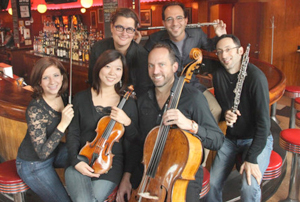by Timothy Robson

Ensemble HD includes flutist Joshua Smith, violinist Amy Lee, cellist Charles Bernard, oboist Frank Rosenwein, and violist Joanna Patterson Zakany, and pianist Christina Dahl, who is the only non-TCO member in the group.
The performance venues could not be more different. The bar has very dry acoustics and listeners who might or might not be completely attentive. At Christ Episcopal Church the audience was rapt, but the very live acoustics of the sanctuary proved to be a serious detriment. Much of the detail was lost in the reverberation, and at times the Ensemble seemed to be overplaying, creating a plush, but indistinct, cloud of sound.
The program was intriguing, with two of the three works being rarities. Only Fauré’s Piano Quartet No. 1 in c, Op. 15, is a standard work.
French organist-composer Maurice Duruflé was a painstakingly self-critical composer, completing only a handful of works, the most famous of which is his Requiem. It was a treat to hear his rarely performed Prelude, Recitative and Variations, Op. 3, for flute, viola, and piano. The two outer movements comprise the majority of the work, with a brief recitative forming a bridge between the two. Piano and viola dominate the prelude, but the flute plays a more prominent role in the set of increasingly virtuosic variations. There is none of Duruflé’s Gregorian chant-based impressionism in this austere and dramatic work. The reading here was straightforward, but without the endless flexibility of rhythm that Duruflé learned from his idol and teacher, organist-composer Charles Tournemire.
Bohuslav Martinů’s 1947 Quartet for Oboe, Violin, Cello and Piano, H. 315, was written in New York while the composer was in exile from his native Czechoslovakia after World War II. Much of its short three movements are in a neoclassical style that harkens back to German romanticism, sometimes juxtaposing rapturous melody with spiky harmonies. Here, the church’s acoustics were most problematic, however, Rosenwein, Lee, Bernard, and Dahl gave an intense and committed performance.
The Fauré Quartet that closed the concert was the most successful in this acoustic, partly because the composer frequently builds textures by having the strings play in unisons and octaves above the piano. Lee, Zakany, Bernard, and Dahl enhanced the performance with enormous dynamic contrasts. The Scherzo was particularly attractive, with pizzicato strumming in the strings and fluttery piano figurations. The suave, legato violin melody in the trio is followed by a shortened recapitulation of the Scherzo. The fourth movement returns to Fauré’s octave/unison technique, building to a passionate final climax. This was a solid, satisfying performance.
Published on ClevelandClassical.com November 14, 2017.
Click here for a printable copy of this article



